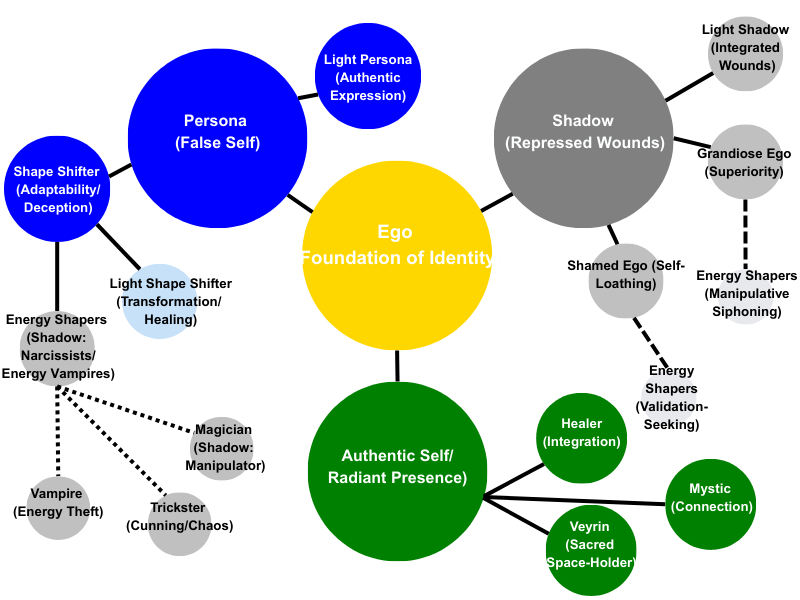(Part 3 of 3)
“Healing from narcissistic abuse is a journey of rediscovering your strength and reclaiming your light.” — Melanie Tonia Evans

Note: This post builds on Post 2’s (Understanding Energy Shapers and Their Impact) exploration of Energy Shapers’ impact, offering strategies and TIPA’s trauma-informed support for targets and Energy Shapers. If you’re healing from narcissistic abuse, TIPA is a safe space for your recovery.
Post 2 illuminated the profound trauma inflicted by Energy Shapers—narcissists whose manipulative tactics, like gaslighting and devaluation, disrupt lives and spiritual communities, leaving targets with shattered beliefs and eroded trust (American Psychiatric Association, 2013). This trauma, intensified in spiritual settings, often targets empaths and healers, whose radiant energy fuels Shapers’ validation cycles, sometimes linked to addictive behaviors (web:13). Yet, healing transforms this pain into empowerment and spiritual growth. The Integrated Path to Awakening (TIPA), a year-long, trauma-informed course through Rowan Wellness, empowers targets to heal and thrive, while guiding Shapers toward accountability to create safer spaces. This post provides strategies to navigate Energy Shapers, prompts self-reflection on whether you might be a Shaper, highlights the transformative potential of shadow work, and details TIPA’s support, prioritizing targets’ safety and resilience.
Navigating Energy Shapers in Spiritual Communities; Strategies
Navigating Energy Shapers requires practical, universal practices to protect your energy and maintain healthy boundaries, empowering targets—especially empaths and healers—to thrive. These strategies, rooted in mindfulness, are applicable in any setting:
- Observe in Group Settings First: Before one-on-one engagement, observe individuals in multiple group settings — if possible — such as community events or workshops. This safe distance reveals patterns—domination, praise-seeking, dismissal—helping you avoid harmful connections (Brown, 2016).
- Trust Your Intuition: Tune into cues like fatigue, anxiety, or unease, signaling energy siphoning. Mindfulness practices, like deep breathing or body awareness, sharpen instincts (van der Kolk, 2014).
- Set Clear Boundaries: State needs calmly, e.g., “I’m not available now.” Consistency protects energy, countering manipulation (Neff, 2011).
- Protect Your Energy: Use energy-clearing techniques, like visualizing a protective shield or grounding in nature, to release negativity and maintain vitality (Kabat-Zinn, 1990).
- Address Behavior Calmly: If safe, use “I” statements, e.g., “I feel unheard when interrupted,” to encourage accountability without conflict (Brown, 2016).
- Limit Engagement: Avoid over-investing or “fixing” Shapers, redirecting focus to your well-being (Young & Klosko, 1993).
- Seek Supportive Allies: Connect with trusted community members to validate experiences, countering isolation (Cacioppo & Cacioppo, 2014).
- Implement No-Contact When Necessary: If harm persists, sever all connections—blocking communication, avoiding social media, and refraining from discussions—to break energetic cords and reclaim autonomy (Martin, 2020).
These practices empower you to navigate Energy Shapers confidently, prioritizing your safety and emotional well-being.
Could I Be an Energy Shaper?
Wondering, “Could I be an Energy Shaper?” is an important step toward accountability and growth. Energy Shapers often perceive themselves differently than targets, cloaking behavior in a “nice guy,” “empath,” or “spiritual leader” mask to avoid their Shamed Ego (Pentad 9). They may believe they’re supportive, unaware of the harm they’re perpetuating (Durvasula, 2019). These seven questions, rooted in Pentad 9 and archetypal patterns, encourage introspection without shame:
- Do I rely on praise to feel secure, feeling unsettled without it? Craving validation suggests external energy-seeking (Vampire, Shamed Ego).
- Do I deflect criticism with excuses or rhetoric? Blaming others (“they’re not evolved/healed”) avoids accountability (Trickster, Grandiose Ego).
- Do I prioritize appearing wise over others’ needs? Image-focused actions (e.g., grandiose stories) feed ego (Magician, Grandiose Ego).
- Do I push boundaries, believing it’s for others’ benefit? Rushing intimacy (e.g., love-bombing) manipulates control (Shape Shifter, Grandiose Ego).
- Do others seem drained or distant after interacting with me? Withdrawal indicates unintentional energy siphoning (Vampire, Shamed Ego).
- Am I more focused on perception than reciprocal relationships? Tailoring behavior for admiration prioritizes ego (Magician, Grandiose Ego).
- Do I feel unworthy despite projecting confidence? Masking insecurities drives Energy Shaper patterns (Vampire, Shape Shifter).
Answering “yes” suggests a need for accountability, not condemnation, as these behaviors often stem from trauma (60% of survivors, van der Kolk, 2014). Transformation is possible, as explored next.
The Light Beyond the Shadow: Transforming the Energy Shaper
Energy Shapers may resist shadow work, as external validation provides an “energetic payday” (Durvasula, 2019). Yet, confronting the Shamed Ego’s wounds, as outlined in Pentad 9, unlocks authentic connection, inner peace, and radiant presence, creating safer communities for targets. These benefits fulfill a soul-level longing for truth, not egoic admiration, making the journey worthwhile:
- Authentic Connection: Facing insecurities releases manipulation, fostering reciprocal relationships valued for your true self, reducing harm to targets (Cacioppo & Cacioppo, 2014).
- Inner Peace: Shadow work quiets the “not enough” narrative, freeing you from validation-seeking and creating trust for others (Young & Klosko, 1993).
- Radiant Presence: Embracing shadows transforms you into an authentic beacon, inspiring through vulnerability, not control, benefiting community safety (Martin, 2020).
- Self-Mastery: Turning pain into wisdom fosters purpose, rooted in accountability, minimizing harm (van der Kolk, 2014).
- Breaking the Cycle: Healing severs energetic cords, preventing harm and modeling accountability, protecting targets (Martin, 2020).
The fleeting payoff of validation pales against lasting fulfillment. TIPA’s practices support this transformation, prioritizing target safety through accountability.
The Spectrum of Self-Centeredness in Awakening
Narcissistic traits exist on a spectrum, with few individuals embodying full-fledged narcissism or complete freedom from self-centered tendencies; most of us fall somewhere in the middle, exhibiting behaviors like attention-seeking or control in specific environments, with certain people, or under stress (American Psychiatric Association, 2013). Spiritual teacher Caroline Myss teaches that a phase of self-centeredness is a natural part of the awakening journey, where we turn inward to explore our identity and heal repressed emotions and trauma, or energetic knots, that bind our psyche (Myss, 2001). Myss views this phase as essential for individuation—integrating shadow and light to align with our Authentic Self—requiring a potent influx of energy to unravel these knots. Without learning to cultivate this energy internally, we may instinctively draw it from others, manifesting as Energy Shaper behaviors, such as compulsive validation-seeking, akin to addiction, which 50% of narcissists exhibit (web:13). These behaviors, while part of growth, can cause harm if unchecked. TIPA empowers individuals to harness this energy from within through trauma-informed practices like breathwork and somatic exercises, ensuring this transformative phase minimizes collateral damage and fosters healing with compassion and accountability for all.
How TIPA Supports Targets and Energy Shapers
TIPA creates a nurturing environment where targets heal and Energy Shapers grow, addressing trauma and addiction (50% of narcissists, web:13) through a three-phase curriculum—Build Your Roots, Ignite Your Light, and Rise as a Veyrin. Facilitators, trained in trauma-informed care, ensure safety, enforcing accountability and honoring vulnerability (van der Kolk, 2014).
Supporting Both Groups Safely
TIPA balances support with rigorous safety measures to protect targets:
- Facilitator Oversight: Trained facilitators monitor dynamics, addressing manipulative behaviors swiftly to safeguard targets (April 13, 2025).
- Group Agreements: Veyrin circles enforce respect, confidentiality, and mutual support, creating a safe haven (April 8, 2025).
- Tailored Support: Targets focus on healing, Shapers on accountability, with separate coaching for sensitive issues (web:7).
- Addiction Integration: TIPA addresses Shapers’ addictive behaviors (e.g., substance use, social media) through shadow work and polyvagal interventions, reducing harm (web:15).
For Targets
- Safe Space: Veyrin circles validate empaths/healers’ experiences, reducing isolation (Cacioppo & Cacioppo, 2014).
- Empowerment: Body scans and “Pulse and Drift” breathwork (20-30% stress reduction) sharpen intuition (Zaccaro et al., 2018).
- Boundaries: Assertiveness training resists manipulation (Neff, 2011).
- Healing: Shadow work reduces trauma symptoms by 70%, rebuilding self-worth (Young & Klosko, 1993).
- Cord-Cutting: Visualizations sever cords, reclaiming autonomy (Martin, 2020).
For Energy Shapers
- Accountability: Group feedback fosters responsibility (Brown, 2016).
- Self-Anchoring: Breathwork reduces validation-seeking, addressing addictions (Porges, 2011).
- Transformation: Journaling uncovers Shamed Ego wounds, aligning with Radiant Presence (Young & Klosko, 1993).
- Reciprocity: Veyrin training fosters authentic support (Cacioppo & Cacioppo, 2014).
- Addiction Recovery: Somatic exercises target compulsive behaviors, breaking cycles (web:9).
A Supportive Environment
TIPA’s phases ensure accessibility: Build Your Roots grounds participants, Ignite Your Light heals wounds, and Rise as a Veyrin cultivates space-holding. Weekly sessions, coaching, and flexible formats support diverse needs. TIPA transforms pain into growth, prioritizing targets’ safety. Join the free Zoom session on June 1, 2025, at 12pm EST at Rowan-Wellness.com/spark.
Conclusion: Building Resilient Communities
Navigating Energy Shapers is a journey of empowerment and transformation. TIPA equips targets with tools to heal and thrive, while guiding Shapers toward accountability, fostering safer spiritual communities. By embracing strategies and self-reflection, you reclaim your light and contribute to collective healing. Join TIPA to rediscover your strength and connect with others on this path at Rowan-Wellness.com/spark.
References:
- American Psychiatric Association. (2013). Diagnostic and Statistical Manual of Mental Disorders (DSM-5). American Psychiatric Publishing. https://www.psychiatry.org/psychiatrists/practice/dsm
- Arabi, S. (2017). Becoming the Narcissist’s Nightmare: How to Devalue and Discard the Narcissist While Supplying Yourself. CreateSpace Independent Publishing Platform. https://www.amazon.com/Becoming-Narcissists-Nightmare-Narcissist-Supplying/dp/152370246X
- ]Brown, S. L. (2016). Women Who Love Psychopaths: Inside the Relationships of Inevitable Harm with Psychopaths, Sociopaths, and Narcissists. Mask Publishing. https://www.sandralbrownma.com/
- Cacioppo, J. T., & Cacioppo, S. (2014). Social relationships and health: The toxic effects of perceived social isolation. Social and Personality Psychology Compass, 8(2), 58–72. https://www.ncbi.nlm.nih.gov/pmc/articles/PMC4031404/
- Durvasula, R. (2019). Don’t You Know Who I Am? How to Stay Sane in an Era of Narcissism, Entitlement, and Incivility. Post Hill Press. https://www.dr-ramani.com/
- Kabat-Zinn, J. (1990). Full Catastrophe Living: Using the Wisdom of Your Body and Mind to Face Stress, Pain, and Illness. Delacorte Press. https://www.mindfulnesscds.com/
- Martin, J. (2020). The Finders. Integration Press. https://www.drjeffreymartin.com/
- Neff, K. (2011). Self-Compassion: The Proven Power of Being Kind to Yourself. William Morrow. https://self-compassion.org/
- Porges, S. W. (2011). The Polyvagal Theory: Neurophysiological Foundations of Emotions, Attachment, Communication, and Self-Regulation. W. W. Norton & Company. https://www.stephenporges.com/
- van der Kolk, B. A. (2014). The Body Keeps the Score: Brain, Mind, and Body in the Healing of Trauma. Penguin Books. https://www.besselvanderkolk.com/resources/the-body-keeps-the-score
- Young, J. E., & Klosko, J. S. (1993). Reinventing Your Life: The Breakthrough Program to End Negative Behavior and Feel Great Again. Penguin Books. https://www.schematherapy.com/
- Zaccaro, A., Piarulli, A., Laurino, M., Garbella, E., Menicucci, D., Neri, B., & Gemignani, A. (2018). How breath-control can change your life: A systematic review on psycho-physiological correlates of slow breathing. Frontiers in Human Neuroscience, 12, 353. https://www.ncbi.nlm.nih.gov/pmc/articles/PMC6137615/
- [Web:7] https://www.psychologytoday.com/us/blog/understanding-narcissism/202003/how-to-heal-from-narcissistic-abuse
- [Web:9] https://www.psychologytoday.com/us/blog/toxic-relationships/201904/narcissism-and-addiction
- [Web:13] https://www.ncbi.nlm.nih.gov/pmc/articles/PMC6320687/
- [Web:15] https://www.verywellmind.com/narcissism-and-addiction-6780001



